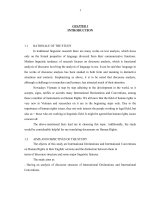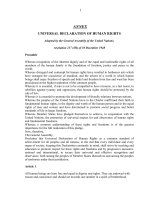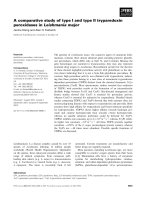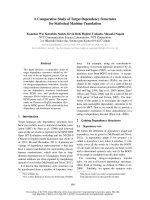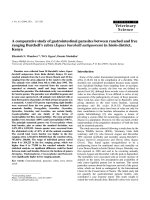A comparative study of discourse structures and some major linguistic features of international declarations and international conventions on human rights part 3
Bạn đang xem bản rút gọn của tài liệu. Xem và tải ngay bản đầy đủ của tài liệu tại đây (221.39 KB, 41 trang )
Chapter I
Introduction
1.1 RATIONALE OF THE STUDY
In traditional linguistic research there are many works on text analysis, which focus only
on the formal properties of language divorced from their communicative functions. Modern
linguistic tendency of research focuses on discourse analysis, which is functional analysis of
discourse involving the analysis of language in use. It can be said that language in the works of
discourse analysis has been studied in both form and meaning in distinctive situations and
contexts. Emphasizing as above, it is to be noted that discourse analysis, although a challenge to
researchers and learners, has attracted much of their attention.
Nowadays Vietnam is step by step adhering to the development in the world, so it
accepts, signs, ratifies or accedes many International Declarations and Conventions, among
these a number of instruments on Human Rights. We all know that the field of human rights is
very new in Vietnam and researches on it are in the beginning steps only. Due to the importance
of human rights issues, they not only interest the people working in legal field, but also us
−
those who are working in linguistic field. It might be agreed that human rights issues concern
all.
The above-mentioned facts lead me to choosing this topic. Additionally, the study would
be considerably helpful for my translating documents on Human Rights.
1.2 Aims and Objectives of the study
The objects of this study are International Declarations and International Conventions on
Human Rights in their English versions and the distinction between them in
terms of discourse structure and some major linguistic features.
The study aims at:
- Having an analysis of discourse structure of International Declarations and International
Conventions.
1
- Having remarks on some major linguistic features used in International Declarations and
International Conventions on Human Rights.
- Finding distinctions between these two types of basic documents on Human Rights in terms of
discourse structure and major linguistic features.
1.3 Scope of the study
Due to the scope of a minor M.A. thesis, 6 documents are selected for the investigation,
3 Declarations and 3 Conventions. The English language used in these documents are authentic,
as they all are original English versions of these Declarations and Conventions, which are issued
by the United Nations. These documents are named in the Sources of data (see page 43 below,
please). Two of these (Universal Declaration of Human Rights and Convention on the Rights of
the Child), which are most popular, are enclosed in the Annex.
Within the frame of a minor M.A. thesis, the analysis is confined to discourse structure
and some major linguistic features used in these documents at initial steps only. The limitations
of this work would be good starting points for further studies on the issue.
1.4 Methods of the study
Firstly, 6 documents are carefully selected. They are popular instruments on Human
Rights with the topics, which are the common concerns for all people. The linguistic
expressions in these documents are typical for International Declarations and International
Conventions on Human Rights.
Secondly, these documents will be then described, analyzed in terms of discourse
structure and some major linguistic features.
Thirdly, the data obtained will be dealt with in order to reach some conclusions on
typical similarities and differences between Declarations and Conventions on Human Rights in
terms of discourse structure and some linguistic features, and necessary comments should be
made accordingly.
The approach to the study is inductive, based on a collection of sample documents.
1.5 ORGANIZATION OF THE STUDY
2
The thesis is comprised of 5 chapters. Chapter 1 and Chapter 2, like those of any thesis,
are Introduction and Literature Review telling about the purposes and reasons of the topic
choosing; aims and objectives; scope; methods and theoretical background of the study. They
are usual necessary parts of every paper. Chapter III explores the discourse structure and some
major linguistic features of International Declarations on Human Rights. In the initial
organization, Chapter IV would explore the discourse structure and some major linguistic
features of International Conventions on Human Rights and there should be a separate Chapter
−
Chapter V
−
for comparison. But to do this would look cumbersome, therefore, in this paper
Chapter IV explores the discourse structure and some major linguistic features of International
Conventions in comparison with those of International Declarations to avoid repetition.
However, there still needs be Chapter V, where findings of overall similarities and differences
between the International Declaration and the International Convention on Human Rights in
terms of discourse structure and some major linguistic features are noted as the conclusion of the
study. The diagrams of typical structures of the International Declaration and the International
Convention on Human Rights are drawn at the end of the paper for readers to have an overall
look on. Two of the most popular documents on Human Rights in the world and in Vietnam as
well (a Declaration and a Convention) are enclosed in the Annex. It would be good for the
readers to read through full original English versions of these documents.
Chapter II
3
literature review
2.1 Discourse and discourse structure
2.1.1 Discourse
There are many statements by well-known linguists on discourse. These statements
might have either similar meanings or not totally similar. Through reading, in my opinion, the
answer to the question 'What is discourse?' can be seen clearly in Cook's (1989: 44) explanation:
"discourse is like a moving film, revealing itself in time
−
sometimes over long periods."
Discourse can be described in the figure below:
time
the world (social and physical)
language
thought (knowledge and reasoning)
(Adapted from Cook 1989: 44).
Foreign language learners need to enter into long stretches of communication, in real and
complex situations. We need to build further on the ideas we have covered so far, to look at
longer stretches of discourse, to form a picture of discourse in totalities rather than in extracts.
Or discourse can be defined briefer as: "is to refer to the interpretation of the
communicative events involving language in context" (Nunan 1992: 6).
2.1.2 Discourse Analysis
Discourse analysis examines how stretches of language, considered in their full textual,
social, and psychological context, become meaningful and unified for their users. It is a rapidly
expanding field, providing insights into the problems and processes of language use and
language learning, and is therefore of great importance to language teachers. Traditionally,
language teaching has concentrated on pronunciation, grammar, and vocabulary, and while these
4
Discourse
remain the basis of foreign language knowledge, discourse analysis can draw attention to the
skills needed to put this knowledge into action and to achieve successful communication.
2.1.3 Discourse structure
2.1.3.1 What is discourse structure?
The concept 'discourse structure' has been studied and expanded in the theory of
discourse analysis. Many researchers have used different terms, but in general they convey the
similar content. They try to establish the relationship between discourse structure and the
purpose or implication of the speakers, and finally they give out the method of analyzing
discourse structure based on the relationship of the factors of discourse. Mann and Thompson
(1992) pointed out the two relationships, namely Nuclear (N) and Satellite (S), and identified
such relations as Circumstance, Solutionhood, Elaboration, Antithesis and Concession,
Background, Enablement and Motivation, Evidence and Justification, Relation of Cause,
Purpose, Condition and Otherwise, Interpretation and Evaluation, Restatement and Summary,
and lastly Sequence and Contrast. The types of relation between N and S do not completely
follow stable order, for instance, N may go before S or in contrast S may go before N. However
in English Mann and Thompson provide some common types. When N goes first, the relation
are Elaboration, Enablement and Motivation, Evidence and Justification, Purpose, Restatement
and Summary because new information often stands at the end. When S goes before N, the
relations are Antithesis and Concession, Background, Condition and Otherwise, Justification
and Solutionhood. Basically, researchers admitted that texts, in spite of their confusing look,
have their own structures.
2.1.3.2 Two views of discourse structure: as product and as process
There are two approaches to discourse structure: the Birmingham School has deal only
with formal discourse, and with large structures which become evident after the event; the
ethnomethodologists have eschewed these large structures and concerned themselves with
local transitions and only with casual conversation.
Ethnomethodologists view discourse as a developing process, rather than a finished
product; and this, after all, is how the participants must be handling it and making sense of it,
5
without the benefit of transcription and post hoc theorizing. They depict conversation as
discourse constructed and negotiated between the participants, following pre-established
patterns, and marking the direction they are taking in particular ways: with pauses, laughter,
intonations, filler words, and established formulae. These conventions enable the participants to
orientate to what is happening, and rapidly make sense of the interaction.
2.1.4 Thematization
A consideration in the arrangement of information in a sentence or utterance is the
prominence or importance that the speaker or writer wishes to give different pieces of
information. Theme is a formal grammatical category which refers to the initial element in a
sentence or utterance which forms the point of departure. It is the element around which the
sentence is organized, and the one to which the writer wishes to give prominence. The
remainder of the sentence or utterance is known as the Rheme. Thematization is the process of
giving prominence to certain elements in a sentence or utterance by placing them at the
beginning of the sentence or utterance. When moving beyond the sentence to discourse, the
issue of thematization becomes particularly important as the writer has to arrange information in
terms of given/new and also in terms of desired thematic prominence.
2.2 SOME MAJOR LINGUISTIC FEATURES
2.2.1 Modality
A modal form is a provision of syntax that indicates the predication of an action,
attitude, condition, or state other than that of a simple declaration of fact. The modality of a
grammatical form is the quality or state in question. These include the assertion or denial of any
degree or manner of affect, belief, certainty, desire, obligation, possibility, or probability on the
part of the utterer. Modal verbs, like 'can'; 'could'; 'may'; 'shall'; 'should'; 'will';'would',
'must'; 'ought to'; 'dare' and 'need', express distinctions of mood, such as that between
possibility and actuality.
2.2.2 Active and Passive voices
6
In grammar, the voice of a verb describes the relationship between the action (or state)
that the verb expresses and the participants identified by its arguments (subject, object, etc.).
* Active voice:
In sentences with active voice, the agent or doer of the action is the subject. The receiver
takes the action of the verb. Active sentences follow the Agent - Verb - Receiver format. In most
nonscientific writing situations, active voice is preferable to passive for the majority of your
sentences. Sentences in active voice are generally
−
though not always
−
clearer and more direct
than those in passive voice.
* Passive voice:
In passive voice sentences, the receiver of the verb's action become the subject of the
sentence. Sentences that use passive voice include a form of the verb 'be' and the past participle
of the main verb. They follow the Receiver - Verb - by Agent format or leave out the agent.
Writers in general should use passive voice sparingly. Overuse can make writing seem flat,
uninteresting and confusing. However, passive voice is good to be used in cases such as
following:
- when emphasizing the Receiver is more important than emphasizing the agent of the
action;
- when agent is unknown;
- when your discipline uses it a part of its discourse in order to make writing appear
objective and fact-based.
Scientists often use passive voice because the process or result is more important than the
researcher conducting the experiment. Business writing also calls for passive voice to remove
blame and to appear tactful.
2.2.3 Kinds of Sentence
* Simple sentence (or an independent clause) is a group of words that has a subject
and a verb. As it is a part of a sentence but grammatically independent, it could stand alone as a
main clause. The writer try to take full advantage of such useful structure when they want to
express complex and logical relationship among ideas producing extremely complex sentences
7
that may cause trouble for readers. It should be noted that a simple sentence, in some linguists'
opinion now, no longer consists only subject and verb, but its extension (nouns phrase, clauses
without 'to').
* Complex sentence (Main Clause plus one or more Independent Clause)
The popular way to connect two ideas in a sentence is to make one into a main clause
and the other into an explanatory or dependent (subordinate) clause in order to make the text
cohesive. In fact, a complex sentence often consists of more than one subordinate clause. By
this way, related ideas can be linked to make the text sufficient and coherent.
* Compound sentence (Main Clause plus Main Clause)
Two sentences or two main clauses that are joined by a comma or some conjuncts like
'for, any, nor, but, or, yet, so,' are the most frequent
−
used structure in the English language
because most of language freely use 'and, but, so, or' or even a comma between main clauses.
* Compound-Complex sentence (two or more main clauses plus one or more
dependent clauses)
The structure of this kind can not be firmly described but in general, it can be described
as follows: Main Clause and Main Clause that Dependent Clause or Main Clause that
Dependent Clause, and Main Clause that Dependent Clause.
2.2.4 Special Words
* Archaic words/ phrases are the ones no longer in dictionary use, though retained for
special purposes. This type of words often appear in the works of formal style in general, in
legal documents in particular. Therein; hereby; thereof, whereof, notwithstanding;…are some
samples for archaic words and in accordance with; pursuant to; with respect to, with access to;
… are some archaic phrases often used in legal document.
* Technical words in legal field can be understood as linguistic means which contribute
to the Clarity and Airtightness of legal documents. Technical terms define typical words or
phrases on specific fields. These terms build the technicality
−
a particular features of a type of
documents. Jurisdiction; immunities; conciliation, tribunal,… are technical words, which often
used in legal documents.
8
*Borrowed words are the ones originated by another language. In official document in
general and in legal ones in particular borrowed words are normally the Latin ones.
2.2.5 Speech acts
Speech act theory provides us with a means of probing beneath the surface of discourse
and establishing the function of what is being said. This helps us to postulate structures beneath
the surface, sequences and relation of acts. It may help us be able to examine the structure of
discourse both in terms of surface relations of form, and underlying relations of functions and
acts. Depending on functions, Searle (1969, 1976) classify 5 types of speech acts as following:
- Declaratives are those kinds of speech acts that change the world via the utterance with some
typical verbs: declare, pronoun, resign…
- Representatives are those that state what the speaker believes to be the case or not. They state
facts, assertions, conclusions and descriptions.
- Expressive are those kinds of speech acts that state what the speaker feels. They express
psychological states and can be statement of pleasure, pain, likes, dislikes, joy or sorrow.
Some typical verbs used are excuse, congratulate, wish,…
- Directives are those kinds of speech acts that speakers use to get someone else to do
something. They express what the speaker wants. They are commands, orders, requests,
suggestions expressed by verbs as order, command, request, allow,…
- Commissives are those kinds of speech acts that speakers use to commit themselves to some
future action. They express what the speaker intends. They are promises, threats, refusals,
pledges performed by verbs: pledge, swear, promise, offer,…
The self-obvious concepts for every one, for instance, sentences beginning with subject/
with adverbial phrase/ with 'If clause'…, are not necessarily defined here.
CHAPTER III
THE DISCOURSE STRUCTURE AND SOME MAJOR LINGUISTIC FEATURES
OF THE INTERNATIONAL DECLARATION ON HUMAN RIGHTS
9
3.1 DEFINITION OF AN INTERNATIONAL DECLARATION
'International Declaration' generally is defined as "a formal statement agreed on or
used by all or many nations". (Oxford Modern English Dictionary, 1994, page 269). In legal
field 'Declaration' can be understood as "An unworn statement that can be admitted in evidence
in a legal transaction" or "A document or instrument containing such statement or
proclamation".
3.2 PURPOSES AND TYPICAL LEGAL CHARACTERISTICS OF THE
INTERNATIONAL DECLARATION ON HUMAN RIGHTS
3.2.1 Purposes
Purposes of the International Declaration may be identified as follows:
- To proclaim common standards of achievement for all peoples and all nations all over the
world or in a region (universal or regional Declaration) without discrimination of any kinds as to
race, geographical or political status.
- The general aim of all Declaration on Human Rights is encourage and assist all the States, who
are members of the United Nations in promoting human rights exercising of all people all over
the world.
3.2.2 Typical legal characteristics
The International Declaration has following typical characteristics:
- Each Declaration is drawn up based on the common consent of sides.
- Each Declaration is promulgated and adopted by a right authoritative agency.
- Each Declaration is an international legal instrument, which will be exercised for all objects
of it without discrimination of any kinds as to race, geographical or political status (e.g.: the
Universal Declaration will be aimed at states all over the world; a regional one will be aimed
at all the states in the region,…).
- Declaration is a non-legalbinding instrument, i.e. its provisions are recommendatory only,
they are not enforceable or obligatory.
10
3.3 A STUDY OF THE DISCOURSE STRUCTURE AND MAJOR LINGUISTIC
FEATURES OF INTERNATIONAL DECLARATIONS ON HUMAN RIGHTS
An International Declaration comprises its Title, Preamble and articles. Now we have a
look throughout selected texts of International Declarations to find out the typical structure and
major linguistic features of an International Declaration in English.
3.3.1 The Beginning
The Beginning of a Declaration is its Preamble followed the Title.
3.3.1.1 The Title and Preamble of the Declaration and their realization
- The Title and Preamble is the part providing readers with such information, as:
+ The topic, objectives and scope of the Declaration, which can be found right in its Title and in
the last phrase of the Preamble. Additionally, the year of issuing the Declaration is usually
pulled together with its Title.
E.g.: Universal Declaration of Human Rights, 1948 (Title).
…Now, therefore, the General Assembly proclaims this universal declaration of
human rights as a common standard of achievement for all peoples and all nations…(last
phrase of the Preamble).
+ The purposes, basis (theoretical, practical and legal basis) and reasons for making the
Declaration.
E.g.:… the urgent need for the universal application to women of the rights and principles with
regard to equality, security, liberty, integrity and dignity of all human beings…
… violence against women is an obstacle to the achievement of equality, development and
peace,…
+ The related instruments issued before.
E.g.: Charter of United Nations, Universal Declaration of Human Rights, International
Covenants on Civil and Political Rights (Declaration on Protection from Torture).
+ Authoritative agency of adoption: International Declarations mostly are adopted by the United
Nations General Assembly. The Regional ones are adopted by the highest authoritative
11
agency for the region.
- Preamble of a Declaration mostly looks like a short paragraph but it is made up of just a
complex sentence, so it conveys a lot of information in only one sentence. Preamble is often
written in active voice. The subject and the predicate of this complex sentence are often divided
by many subordinate clauses, which all start with participles or adjectives.
E.g.: The General Assembly,
Recognizing the urgent need for the universal application to women of the rights…
Noting that those rights and principles are enshrined in international instruments…
Concerned that violence against women is an obstacle to achievement of equality…
Recalling the conclusion in paragraph 23 of the annex to Economic and Social Council
resolution…
Convinced that in the light of the above there is a need for…
Solemnly proclaims the following Declaration on the Elimination of Violence
against Women and urges that every effort be made so that it becomes generally known and
respected:… (Declaration on the Elimination of Violence against Women, 1993).
The Universal Declaration of Human Rights has an unique Preamble with all phrases,
followed by the subject 'The General Assembly', starting with 'Whereas'. It made the writing
style more formal as this Declaration is the highest instrument on human rights:
Where as recognition of the inherent dignity and…
Whereas disregard and contempt for human rights have resulted in…
Whereas it is essential, if man is not to be compelled…
3.3.1.2 Remarks
Using the specific sentence, which is extremely long, is a typical feature of a Preamble.
Specifically Preamble of each Declaration is one extreme long sentence with quite many clauses
or phrases. Each of these special sentences consists a huge number of words. Let us take
Preambles of 3 selected Declarations as illustrations.
+ Preamble of Universal Declaration of Human Rights is a sentence with 7 long clauses, which
consists 179 words.
12
+ Preamble of Declaration on Protection from Torture is a sentence with 5 long clauses, which
consists 110 words.
+ Preamble of Declaration on the Elimination of Violence against Women is a sentence with 13
long clauses, which consists more than 300 words.
It needs to be noted that these extreme special sentences appear in Preambles only. It is
certainly very-very difficult for readers to understand such long sentences. Each Preamble is
structuralized as follows: Subject is followed by subordinate clauses, which are broken down
from one another in separate parts and predicational verb stands at the end of the sentence.
E.g.: The General Assembly
Recognizing…
Noting that…
Concerned that…
Affirming…
Reaffirming…
Considering that,…
Having regard to…
… Solemnly proclaims the following Declaration:
3.3.2 The Body
3.3.2.1 The Body of the Declaration and its realization
The body of every document is the most important as it conveys the main contents of the
work. All the provisions, proclaimed by a Declaration, are set in the body of the Declaration in
the form of articles, which are not divided into parts. All the articles are general. There is no
such division of article groups, for instance, regular, obligatory and optional ones.
3.3.2.2 Remarks
a, Use of Grammar
a1. Modality
Having a quick look over an International Declaration in English we easily recognize the
repeated appearance of modal verbs as will, shall, should, may, for instance, among 30 articles
13
of Universal Declaration of Human Rights modal verbs are used in 16 ones (Articles 2, 4, 5, 9,
11, 12, 14, 15, 16, 17, 20, 21, 25, 26, 29, 30) or modal verbs are used in almost articles of both
Declaration on Protection from Torture and Declaration on the Elimination of Violence against
Women, except in article 1 where concepts are defined.
a2. Use of voices
Active We can see that active voice is used in each Declaration. Let us take some
sentences as examples. In Declaration on Protection from Torture we found such sentences, as:
No State may permit or tolerate torture or other cruel, inhuman or degrading treatment or
punishment. (Article 3).
Each State shall keep … (Article 6).
Each State shall ensure … (Article 7)…
Expression "Everyone has the right to…" is repeated in most articles of the Universal
Declaration of Human Rights.
PassiveAs a usual feature, passive verbs are often used in English. The Declaration language is
also not apart from that. Passive voice is popularly used throughout the convention. Normally,
passive verbs are avoided when active verbs convey meanings of the sentences clearly. In case
of sentences complex in structures, unclear in meanings and whose wordings are repetitious,
passive form represents the very good solution to any writers generally and any Declaration-
drafter particularly. This feature can be illustrated through the following examples:
E.g.: In Universal Declaration of Human Rights:
No one shall be held in slavery or servitude…(Article 4). No one shall be subjected to
torture or cruel, inhuman or degrading treatment or punishment. (Article 5)…
"No one shall be…" is also repeated in many other articles of the Declaration.
In the Declaration on the Elimination of Violence against Women:
Violence against women shall be understood … (Article 2).
Women are entitled to the equal enjoyment and protection… (Article 3)…
a3. Sentence order
The sentence order is related to thought patterns and has the effect on making the
14
text. It is determined by which part of a sentence coming first. As surveyed, most of sentences in
a Declaration begin with subjects. This is suitable with linguists' research on cultural Thought
Patterns that the English, in writing, often begins his/her sentences by a subject conveying the
main ideas first, or they normally think of 'who/what' in advance. What is more, there exists
sentences written with the structure of 'If' clause. The other structure that is often used is the
sentence beginning with adverbial phrase. The following examples will be the good
illustrations.
Subject:
E.g.: Everyone has the right to…
No one shall be subjected to …
(These expressions appear in many articles of Universal Declaration of Human Rights)
Each State shall keep… (Article 6)
Each State shall ensure…(Article 7 of Declaration on Protection from Torture).
'If' clause:
E.g.: If an investigation under Article 8 or Article 9 establishes that an act of torture as
defined in Article 1 appears to have been committed, criminal proceedings shall be
instituted……(Article 10 of Declaration on Protection from Torture).
Adverbial phrase:
E.g.: Wherever there is reasonable ground to believe that an act of torture as defined in
Article 1 has been committed, the competent authorities of the State concerned shall……(Article
9 of Declaration on Protection from Torture).
a4. Length of sentences
Through surveys it is clear that the easiness or difficulty of understanding a text is
related to the length of sentences. Researchers point out that the average number of word in a
sentence varies from 25 to 29 word per a sentence, it is considered difficult for reading. Through
surveying the Declarations it is found that the shortest sentences consist less than 10
words/sentence only while the longest ones consist 50 words or even more than 50
words/sentence, for instance, Article 2, 3, 4, 5 of Declaration on the Elimination of Violence
15
against Women. Conveying a lot of information, these long sentences are extremely difficult for
readers.
a5. Kinds of sentence
Surveying Declarations, it is found that simple and complex sentences are most effective
in the text of a Declaration, compound-complex sentences are fewer and compound sentences
are the fewest. The longest sentences are often complex ones. Here are the typical samples for
each kind of sentence.
Simple sentence
E.g.: Everyone has the right to life, liberty and security of person. (Article 9).
No one shall be subjected to arbitrary arrest, detention or exile. (Article 10 of Universal
Declaration of Human Rights).
Complex sentence
E.g.: Furthermore, no distinction shall be made on the basis of the political, jurisdictional or
international status of the country or territory to which a person belongs, whether it be
independent, trust, non-self-governing or under any other limitation of sovereignty. (Article 2 of
Universal Declaration of Human Rights).
Compound-Complex sentence
E.g.: Where it is proved that an act of torture or other cruel, inhuman or degrading
treatment or punishment has been committed by or at the investigation of a public official, the
victim shall be afforded redress and compensation in accordance with national law. (Article 12
of Declaration on Protection from Torture).
Compound sentence
E.g.: No one shall be held in slavery or servitude: slavery and the slave trade shall be
prohibited in all their forms. (Article 4 of Universal Declaration of Human Rights).
b. Use of vocabulary
b1. Archaic words and phrases
Few archaic words and phrases are found in Declarations. There are only some words/phrases,
such as whereas, set forth herein, in accordance with. It might be explained that Declaration is
16

